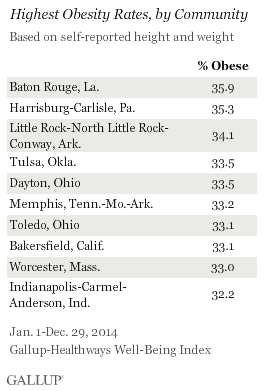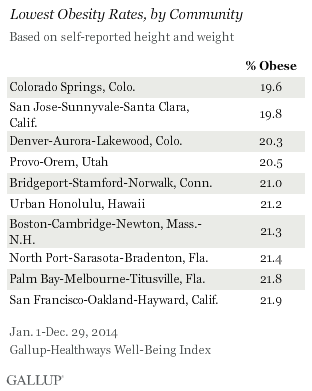America’s obesity levels are still growing in spite of the renewed attention placed on healthy living, with some cities bearing the brunt of the continued upswing. In a study released Thursday, researchers found that 2014 had the highest obesity rate to date: 27.7 percent, nearly a third of America’s population. This is an increase from the 27.1 percent seen in 2013 and a huge jump up from the 25.5 percent of 2008.
Gallup, a researched-based consulting company, partnered with Healthways, a well-being improvement company, and conducted the study. They found that Baton Rouge is the most obese metropolitan area of the 100 communities polled, with an obesity rate of 35.9 percent. The least obese city was Colorado Springs, which had a 19.6 percent rate of obesity.

Of the top ten least obese cities in the nation, only two sit under 20 percent: Colorado Springs and San Jose, with 19.8 percent of its population termed obese.
“All of us in American society and government need to realize that this a disease that is here to stay and needs to be treated in a holistic manner. There is no quick fix for this problem,” Renu Mansukhani, Associate Clinical Director for Medicine at NCWW, said.
Of the 10 cities that have the highest obesity rates, the majority are situated in the South or the Midwest, the only discrepancy being Worcester, Mass. On the other hand, of those areas with the lowest rates, most cities listed are in overwhelming western states with Bridgeport, Connecticut as well as Palm Bay and Sarasota, Florida breaking the mold. And it doesn’t necessarily have to do with how much exercise people are able to get.
“To a degree, lack of opportunity for physical activity is a factor, but the other factors have more importance. The biological and socio-economic factors seem to be the most relevant,” added Mansukhani.

It’s no wonder America is called the “Fast Food Nation,” as, according to Google Maps, there are close to 50,000 fast food chains in America. Kansas, Oklahoma, Arkansas, Kentucky, and Tennessee, as well as many of the states that surround them, top the list of the states with the highest number of fast food restaurants per capita. Kentucky is the worst with 4.1203 restaurants per 10,000 people. Vermont, on the other hand, only has 1.6296 fast food restaurants per 10,000 people.
Those of lower socioeconomic classes, in part because of lack of resources, tend to be diagnosed with diabetes more frequently than those who have access to better eating opportunities.
“It’s too simplistic to say it’s just soda, or just fast food restaurants. Healthy foods are much more expensive therefore [lower classes] tend to eat more at fast food restaurants. Sugar is also coming out as a factor,” Mansukhani said.
Obesity is linked to much more than just health risks like high blood pressure, chronic pain and depression. Gallup and Healthways also concluded that communities that are ranked the highest in obesity have much lower well-being scores and tend to worry about money and have trouble affording food and healthcare.
“There’s a financial burden on communities in terms of lack of productivity, in lack of jobs, in higher healthcare costs,” Mansukhani said.
Despite the apparent connection between self-esteem and obesity, the true cause of each is hard to determine. Mansukhani called it a game of “chicken and an egg” because researchers cannot resolve whether obesity causes low self-esteem, it is the other way around, or something else entirely impacts them both.
“There can absolutely be some stemming of the tide so to speak. What it’s gonna take is a commitment on so many levels of society. Obesity is a disease unto itself and the rest of the nation and some government entities seem to be slower to buy into that concept,” Mansukhani said.
